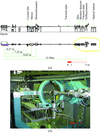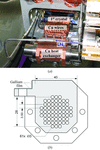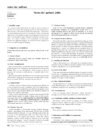issue contents
January 2006 issue

Cover illustration: Snapshots of the diffraction of a micrometre-sized protein crystal during its radation-induced collapse (see Boutet and Robinson, pages 1-7) . The collapse of the crystal causes a shift of the intensity towards higher q with increased dose.
facility information
research papers
The damage caused to protein crystals near 3 µm in size by an unfiltered undulator X-ray beam leads to a lattice contraction and inwards collapse of the crystal.
The new set-up for surface X-ray diffraction experiments at beamline BL9 of the Dortmund Electron Accelerator is presented, along with a discussion of first measurements utilizing X-ray reflectivity and grazing-incidence X-ray diffraction.
In order to reproduce the stress corrosion cracking (SCC) observed in the core shrouds used in boiling water reactors in Japan, an in situ device for synchrotron radiation experiments has been developed. In situ measurements of the stress induced in SUS316L steel by stretching in hot water at a temperature of 561 K and a pressure of 8 MPa have been successfully carried out at SPring-8.
A new method to determine local structure on the basis of XANES fitting is proposed and applied to FeS4, FeO6 and Ni(CN)4 model molecules. The use of multi-dimensional interpolation of spectra as a function of structural parameters allowed the number of required multiple-scattering calculations to be reduced significantly and the development of FitIt software with a visual user-friendly interface.
The undulator beamline of the Structural Biology Center, a national user facility designed and dedicated to macromolecular crystallography, is described, and examples of its use are presented.
Download citation


Download citation


The technical characteristics and performance of a fully-dedicated X-ray powder diffraction beamline at the Brazilian Synchrotron Laboratory are described. The crystal structure of the Ba2FeReO6 double perovskite was investigated at several temperatures, revealing a slight tetragonal distortion in the magnetically ordered phase owing to orbital phenomena.
A double-crystal X-ray monochromator with a thin second crystal, dynamically bent to maintain focus during scanning and with a servo system to maintain constant harmonic rejection, provides high flux over a wide energy range.
A new double-crystal monochromator with an indirect cryogenic cooling system and automatic tuning of the relative angular position of the second crystal is described, and examples of its capabilities are presented.
A white X-ray beam is directly coupled onto the front side of a planar X-ray waveguide and the far-field diffraction pattern is measured using an energy-dispersive detector.
Analytical formulae are developed for easy understanding of single-bounce capillary performance and optimization of capillary length. X-ray tests of various capillary designs at CHESS are summarized.
short communications
The beam produced by an X-ray waveguide has been refocused by an elliptical mirror, providing a submicrometre spot size at large distance (1 m) from the end of the waveguide. This scheme leaves available space for sample environment and allows cross-coupled geometry for production of a nanometre beam in two dimensions.
current events
Free 

notes for authors
Free 



 journal menu
journal menu







































